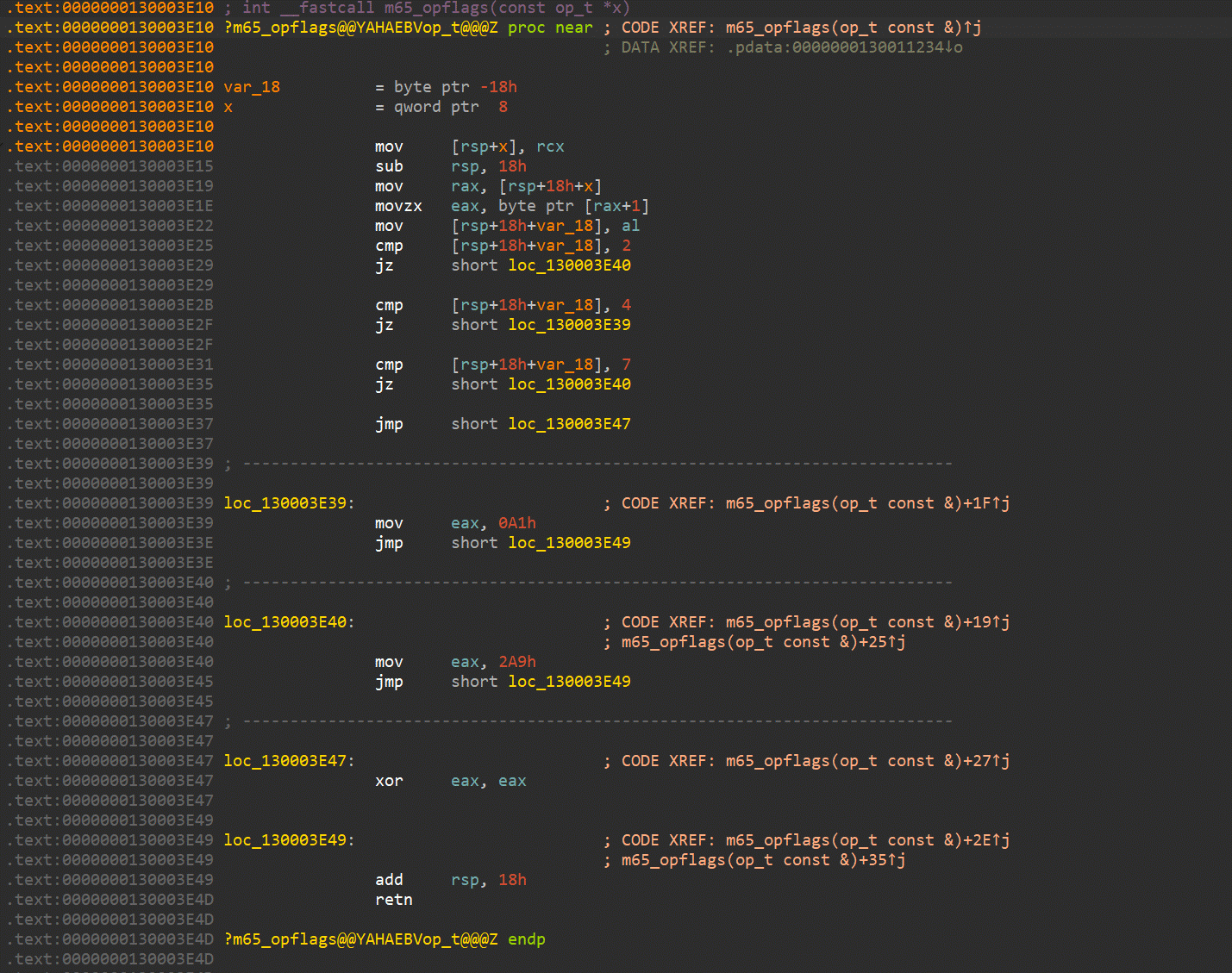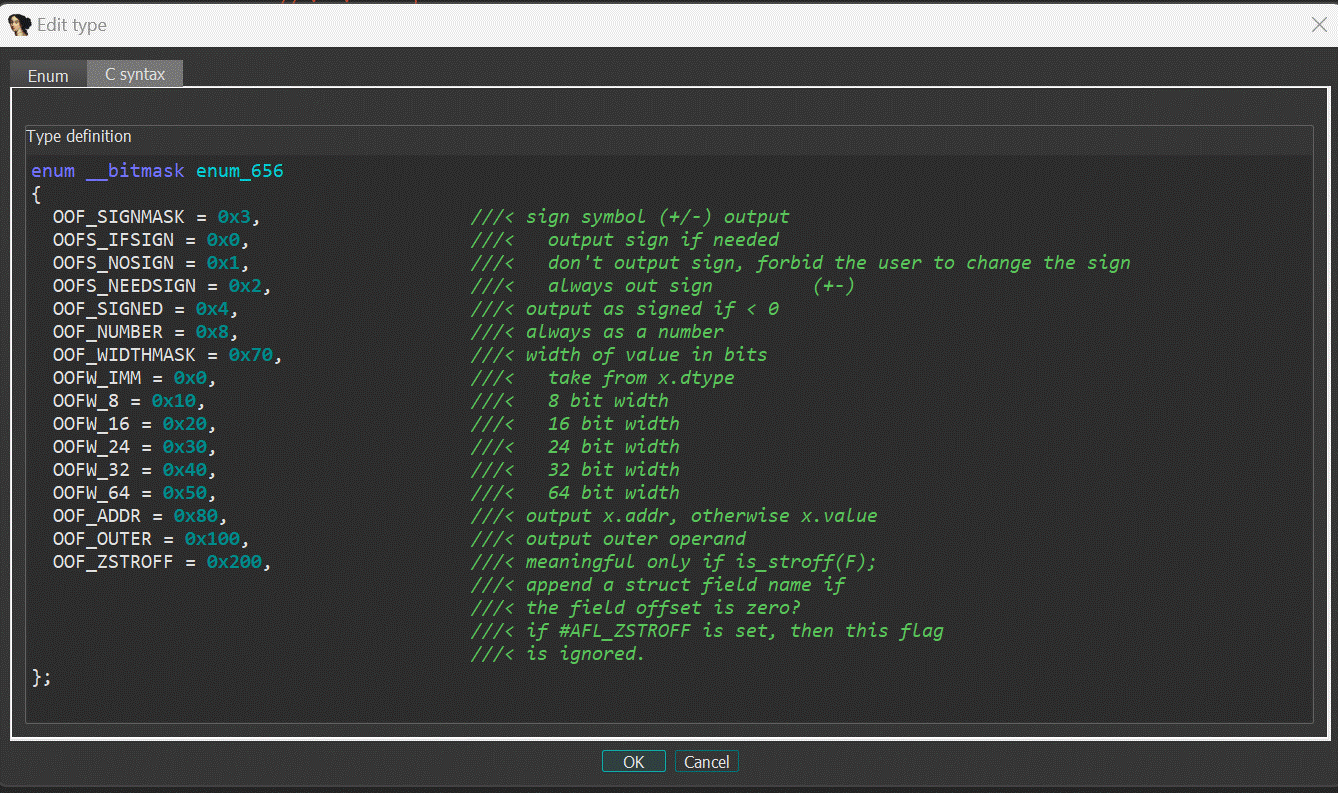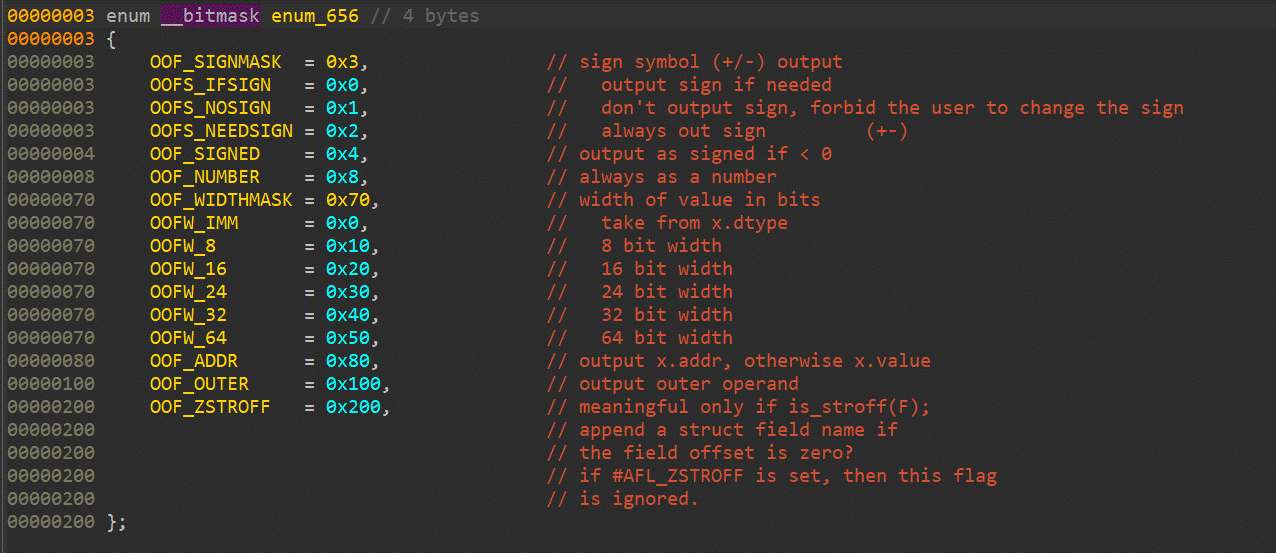有一种特殊的枚举类型:位域。位域是一种被分割成位组的枚举。当你在位域中定义一个新的符号常量时,你需要指定这个常量所属的组。默认情况下,IDA(Interactive Disassembler,交互式反汇编器)建议每个组包含一个位。如果某个组尚未定义,那么在定义该组中的第一个常量时,它会自动被创建。例如:
- name CONST1
- value 0x1
- mask 0x1
将定义一个名为 CONST1 的常量,其值为 1,并会创建一个仅包含一个位的组。
现在,让我们考虑以下更复杂的定义如下所示:
- #define OOF_SIGNMASK 0x0003
- #define OOFS_IFSIGN 0x0000
- #define OOFS_NOSIGN 0x0001
- #define OOFS_NEEDSIGN 0x0002
- #define OOF_SIGNED 0x0004
- #define OOF_NUMBER 0x0008
- #define OOF_WIDTHMASK 0x0030
- #define OOFW_IMM 0x0000
- #define OOFW_16 0x0010
- #define OOFW_32 0x0020
- #define OOFW_8 0x0030
- #define OOF_ADDR 0x0040
- #define OOF_OUTER 0x0080
- #define OOF_ZSTROFF 0x0100
我们对其进行描述如下:
- name value mask maskname
-
- OOFS_IFSIGN 0x0000 0x0003 OOF_SIGNMASK
- OOFS_NOSIGN 0x0001 0x0003 OOF_SIGNMASK
- OOFS_NEEDSIGN 0x0002 0x0003 OOF_SIGNMASK
- OOF_SIGNED 0x0004 0x0004
- OOF_NUMBER 0x0008 0x0008
- OOFW_IMM 0x0000 0x0030 OOF_WIDTHMASK
- OOFW_16 0x0010 0x0030 OOF_WIDTHMASK
- OOFW_32 0x0020 0x0030 OOF_WIDTHMASK
- OOFW_8 0x0030 0x0030 OOF_WIDTHMASK
- OOF_ADDR 0x0040 0x0040
- OOF_OUTER 0x0080 0x0080
- OOF_ZSTROFF 0x0100 0x0100
如果掩码由多个位组成,它可以有一个名称和注释。在定义具有掩码的常量时,可以设置掩码名称。IDA 会以不同的颜色显示掩码名称。
为了在程序中使用位域,只需将指令操作数转换为枚举即可。IDA 将以如下方式显示操作数,
例如,原始指令:
复制代码
将被替换为使用位域常量的形式:
- mov ax, OOFS_IFSIGN or OOFW_8 or OOF_ADDR
使用教程
假设源代码看起来像这样:
- void out_operand(int opnum, int flags);
-
- // 'flags' parameter is combination of the following bits:
- // (don't use OOF_SIGNMASK and OOF_WIDTHMASK, they are for the kernel)
-
- #define OOF_SIGNMASK 0x0003 // sign output:
- #define OOFS_IFSIGN 0x0000 // output sign if needed
- #define OOFS_NOSIGN 0x0001 // should not out sign ()
- #define OOFS_NEEDSIGN 0x0002 // always out sign (+-)
- #define OOF_SIGNED 0x0004 // output as signed if
-
-
- // This function output the first 2 operands of instruction
- void out_operands(void)
- {
- // the first operand is a signed value
- out_operand(0, OOFS_IFSIGN|OOF_SIGNED|OOFW_IMM);
- // the first operand is a unsigned 32bit address
- out_operand(1, OOFS_NOSIGN|OOF_ADDR|OOFW_32);
- }
我们有一个像这样的反汇编代码:

现在,让我们通过使用位域来改进它。我们首先打开一个枚举窗口(菜单 View|Enumerations),在那里我们按 Ins 键创建一个新对象,并将其设置为位域。位域的名称不太重要。我们按 Ctrl-N 来定义位域的值。

第一个位域掩码是 3(或 2 位)。掩码的名称不被 IDA 使用,它只是作为一个记忆辅助工具。在这个字段可以取的 4 个值中,我们只定义了第一个值,0,并给它分配了一个名称:OOFS_IFSIGN。如果我们想在该字段的范围内定义其他值,我们只需要重复这个过程。加上一些注释,定义就变成了

我们切换到反汇编窗口(或按 Alt-F3 关闭枚举窗口)。通过 Edit|Operand types|Enum member 菜单,我们选择刚刚定义的枚举类型,并得到这样的结果:

|